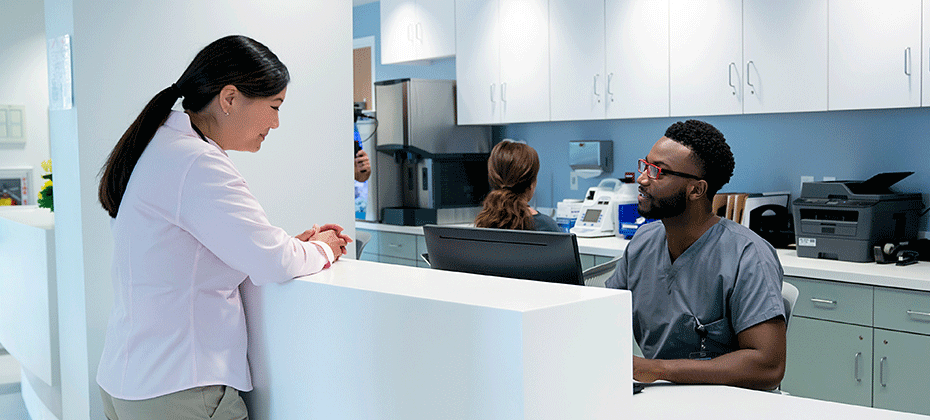Tag: patient experience

Advances in medical treatments and technology are ushering in a new era of personalized healthcare. Each patient has their own distinct medical history, genetics, lifestyle and preferences, and it is increasingly clear that tailored care plans are essential to improve patient outcomes and elevate the overall experience. Personalized patient care has become more critical than ever, and is key to creating better patient experiences. Equally rapid transformations in data analytics, automations and machine learning have opened up new possibilities for non-clinical touchpoints in the patient journey. Providers can leverage digital tools to personalize everything from scheduling to payments, ensuring that patients get the right information at the right time. Targeted patient outreach and tailored payment plans are just two examples of how providers can use digital tools to foster better patient engagement without compromising efficiency – one patient at a time. Why does a personalized patient experience matter? Patient expectations have changed. Wearables, apps and a steady stream of health-related content on social media mean today's patients are better informed and increasingly engaged in their own health. They expect to be treated as equal partners, not as passive participants waiting to be told what to do by their doctor. Rather than one-size-fits-all communications, patients value proactive outreach and relevant reminders and prompts that help them move through their healthcare journey with as little friction as possible. They're also accustomed to “high-choice, high-convenience” digital experiences that tailor information to their specific needs and preferences. Digital consumer brands like Amazon and Google are moving into the healthcare space, leveraging their insights and technology to offer patients tailored medical solutions. To remain competitive in this changing landscape, providers must embrace a personalized approach to care. Aside from attracting higher patient satisfaction scores, a personalized patient experience also contributes to better health outcomes. For example, research shows that unclear post-discharge instructions result in preventable, unplanned, and high-cost follow-up care. Specific and relevant advice and reminders – communicated through the patient's preferred channels – can greatly reduce the risk of no-shows, delays and gaps in care. There are financial benefits too. As patients consistently report concerns about the cost of care, support to understand and manage bills can make a major difference in their propensity to pay. What does personalized patient care look like in practice? Clearly, there are practical limits to the level of personalization that can be offered. But with the right digital tools and data analytics, providers can segment groups of patients and deliver an experience that is sufficiently tailored so it feels like they have their own healthcare concierge. And rather than adding to the operational workload, the data analytics and automations that facilitate personalization can also streamline workflows and improve overall efficiency. In this way, tailoring the patient experience can contribute to a reduced manual workload, fewer errors and faster collections. Providers don't need to compromise efficiency for personalized patient experiences. Two specific areas that offer a high ROI are targeted patient outreach and tailored payment plans. Strategy 1: Targeted patient outreach Experian Health's State of Patient Access survey 2.0 showed that patients appreciate proactive outreach by providers, though many said this didn't always happen. With digital patient outreach solutions, communications can be tailored for different patient segments. Consumer data can allow patients to be grouped according to need, behavior and preferences, so they can be supported to move to the next step in their healthcare journey with ease. For example, patients with specific chronic diseases can be sent reminders for annual health checks. Those that may be due for regular cancer screening can be sent pre-appointment information. Providers can also engage patients with automated, timely messages through their preferred channels. At the individual level, self-service patient access tools and automations allow patients to book appointments when and where it suits them. Automated text message and interactive voice response campaigns can be used to issue links to patients so they can book right away. And automated appointment reminders are an easy way to ensure patients don't forget to attend, while minimizing the business impact. Strategy 2: Tailored payment plans and billing Patients worry about the growing burden of healthcare expenses. Generic payment plans that do not take account of individual patient circumstances can leave patients feeling unsupported and detached, so they're less likely to pay in full and on time. A more patient-centric approach can help patients manage bills and reduce the risk of bad debt. Digital technology can analyze patient financial information to anticipate the patient's propensity to pay and generate a customized payment plan. This should start with proactively issuing accurate estimates of the patient's financial responsibility. Patient Payment Estimates gives patients a simple breakdown of their costs, directly to their mobile. It draws on real-time price lists, payer contracts and relevant insurance details to maximize accuracy. Similarly, Patient Financial Advisor offers patients a text-to-mobile experience with a secure link to billing information, personalized payment plans and convenient payment methods. Those that can pay upfront in full can do so, while those that need a little more time or advice on financial assistance can be directed to the right pathway. Patient Financial Clearance helps determine the optimal payment plan by screening patients automatically before their appointment or at the time of service, to see if they qualify for charity support. Finally, offering a choice of payment methods rounds out a tailored financial offering. Personalized patient care: the key to greater patient satisfaction To sum up, integrating targeted outreach strategies and tailored financial support can help providers increase patient satisfaction, improve health outcomes and enhance financial performance. At the heart of a patient-centric approach should be a commitment to anticipating patient needs, by simplifying their healthcare journey and offering the flexibility and choice that have come to be expected. Explore Experian Health's suite of patient engagement solutions for more ideas on how to deliver a compassionate and personalized patient experience.

The healthcare staffing crisis was one of the biggest challenges facing healthcare providers pre-pandemic, only to be exacerbated by the pressures of dealing with the COVID-19 crisis. Almost a fifth of healthcare workers resigned between February 2020 and September 2021. Unfortunately, the problem isn't in the rearview mirror yet – a new study from McKinsey reveals that worker shortages persist, with 31% of nurses declaring their intent to leave their jobs in the next year. These shortages put pressure on remaining staff, compromise hiring efforts and make high-quality services difficult to maintain. Without a thriving, vibrant workforce, how can healthcare providers meet the needs of their patients? Can automation help address the healthcare staffing crisis? Stubborn staff turnover levels aren't unique to healthcare, but addressing them is even more critical, given the detrimental effect on patients. As the staffing crisis shows no signs of letting up, providers should consider how technologies that leverage automation and AI can help. Tom Cox, President at Experian Health, says, “Automation has transformed many aspects of healthcare, from driving down appeals and denials to improving the digital front door. We're now seeing AI starting to make waves, too. These technologies are the future and are changing healthcare for the better.” Opening healthcare's digital front door is a good place to start. By eliminating repetitive and time-consuming tasks like data entry, manual patient registration and prior authorizations, staff will be freed up to focus on what matters most: delivering high-quality patient care. Here, we look at three areas where automation can simultaneously alleviate the burden of staff shortages and create a better patient experience. Use case 1: automate patient access to manage the growing demand for services Manual and repetitive processes eat up valuable time and create greater workloads that contribute to staff burnout. This is especially true in patient access, which is a typically admin-heavy process. Allowing patients to complete more of their registration and scheduling tasks themselves can reduce the workload in understaffed teams. Many patients prefer not to book appointments through call centers, and high call volumes are a major pressure point for staff. Similarly, manual patient registration is labor-intensive and error-prone, eating up staff time and creating bottlenecks for patients. Automated registration and self-scheduling solutions help patients access care without waiting in phone queues. Patients can book, cancel and reschedule appointments through their mobile devices. On the back end, data can be leveraged to predict and manage demand, while digitized scheduling means agents can spend less time checking referrals against scheduling rules. Automated prior authorizations mean staff no longer need to spend hours poring over payer policies and checking individual payer websites to check for changes – the software updates automatically in real-time. Simplifying these processes with automation not only minimizes operational strain but also reduces friction for patients who want to see the right specialist in the least amount of time. Use case 2: automate personalized patient outreach to reduce call volumes Another way to reduce the administrative burden is with automated patient outreach. Reducing no-shows is an important strategy to promote better health outcomes and boost financial performance. Instead of burying staff with a list of patients to follow up with, providers should utilize automated patient reminders. Automated patient outreach solutions allow providers to segment patients according to their individual needs and preferences, so patients get relevant information through the most appropriate channel. This allows patients to proactively and conveniently manage their own healthcare journey. Automated messages can also be sent to remind patients of outstanding bills and link them to payment options. This means patient collections teams can spend less time on calls and focus instead on meaningful conversations with patients who need extra guidance or support. Use case 3: automate patient collections for faster payments and a better patient experience With fewer staff, patient collections teams must figure out which accounts to prioritize, while navigating increasingly complex payer policies. Advanced data analytics and automation can be used to make these processes more efficient. Similarly, automated patient collections software can screen and segment patient accounts to allow staff to quickly prioritize those with the highest probability of being paid. Collections Optimization Manager offers convenience and clarity to staff with an easy-to-use interface, while targeted collections strategies facilitate conversations with patients based on accurate information and fewer calls and emails. Speed and accessibility create a better experience all around for both patients and staff. Using automated solutions to reduce the pressure of the healthcare staffing crisis Cox says, “Over the last few years, Experian Health has focused on helping providers and payers solve the immediate challenges associated with a remote workforce and staffing constraints while scaling services in response to surging demand. Integrating automation with self-service tools is just the beginning. Our vision is to continue driving innovative and automated solutions that will improve care outcomes and transform our clients' healthcare operations.” These are just a few examples of how automation can create new opportunities for healthcare providers. Digital processes that were once considered merely “nice to have” are now critical components to alleviate the healthcare staffing crisis and deliver positive patient experiences. Contact us to find out more about how Experian Health can help your organization use automation to alleviate the healthcare staffing crisis.

American consumers may be more optimistic about the state of the economy, but concerns about healthcare costs are always top-of-mind. A survey by Experian Health found that 40% of patients would cancel or postpone care if they were not informed of costs in advance. Planning for medical expenses can be a struggle for families facing rising costs and increasing deductibles. With profit margins under increasing pressure, providers must make constant improvements to patient collections processes to help patients navigate their financial obligations more easily. Finding new ways to maximize patient collections and increase efficiency while reducing friction in the patient experience is more important than ever. Technology and patient collections software offer a way to bridge the gap. This article looks at two case studies that involve leveraging automation and digital technology to create better patient collections processes. Case Study 1: how UCSDH improved patient collections with Collections Optimization Manager Patients are footing more of the bill for healthcare, leaving providers more exposed to each individuals' ability to pay. If patients are unable to pay in full and on time, providers will be left with growing – but avoidable – collections costs and an escalating risk of uncompensated care. Given that patients can have different financial circumstances, mailing out uniform statements and hoping they will be paid is a futile effort. Instead, providers should look for opportunities to proactively engage patients with personalized information, delivered earlier in the process. This can help maximize patient collections. One way to determine the most suitable collections strategy for each patient is to use data-driven software like Collections Optimization Manager. This tool helped the University of San Diego California Health (UCSDH) score and segment patients according to their propensity to pay so that each account was dealt with in the most appropriate way. For example, patients with a high likelihood of payment could be sent billing information automatically via inbound call campaigns, and offered self-service options to manage payments. Collections Optimization Manager also enabled UCSDH to automate the presumptive charity process, quickly identify patient accounts eligible for Medicaid or charity support, and direct them to the correct work queue to maximize workforce productivity. As a result, UCSDH increased collections by 250% in a single year, from $6 million to $21 million between 2019-20 and 2020-21. UCSDH also used Coverage Discovery® to track down active commercial and government coverage that patients were unaware of. More than $5 million was found in 2021 that would otherwise have been written off. For UCSDH, being able to provide a compassionate patient collections experience has been central to this success: “We serve our patients well when we can explain their bills, what's been covered by their insurer and what payment options they have, so they feel confident in what is owed and why.” Terri Meier, System Director of Patient Revenue Cycle, UCSDH Case Study 2: how Kootenai Health streamlined eligibility checks with Patient Financial Clearance Another way to provide early clarity is to make sure patients aren't missing out on Medicaid assistance. However, this can be a time-consuming and labor-intensive exercise when attempted through manual processes. Because Kootenai Health needed a more streamlined workflow to screen patients for financial assistance, they implemented Patient Financial Clearance to assess and assign patients to the right pathways and programs, based on their specific circumstances. Patient Financial Clearance uses credit and non-credit data to identify patients missing out on Medicaid or charity assistance in real-time. It automates screening and document-gathering, reducing the manual burden on staff while improving the patient experience. Verifying Medicaid eligibility early prevents patient accounts from being sent down long and expensive collections pathways that would never result in payment. Kootenai's Financial Counseling manager reported that thanks to Patient Financial Clearance, “One of our patients with a $200,000 bill answered a few questions and was found eligible for Veterans benefits. With our previous vendor, we would have written the account off to charity.” In just 8 weeks, Patient Financial Clearance saved Kootenai 60 hours of staff time by automating the presumptive charity process and eliminating unnecessary applications. It also maintained an 88% accuracy in determining the right financial assistance program for the right patient. As Medicaid continuous enrollment under the COVID-19 public health emergency declaration comes to an end, uncertainty around eligibility is likely to increase. Taking steps to verify patients' status quickly and efficiently will be even more important. Bottom line: Maximize patient collections by making it easy to pay These are just two examples of how providers are using automation and digital technology to improve patient collection processes. In addition to screening and segmentation, providers can further tailor the financial experience by offering patients realistic payment plan options to make bills more manageable. Patients are provided with a range of convenient, self-service payment options to settle their bills according to their preferred method. Tools like Patient Financial Advisor allow patients to receive a text message with a link to a clear breakdown of their bill and the option to make a payment right from their mobile device. Find out more about how Experian Health's patient collections software and payment tools can help providers stop chasing the wrong accounts and deliver a proactive and personalized financial experience for patients.

Staffing shortages continue to plague the healthcare industry, creating challenges for both healthcare providers and patients. In a 2022 CVS Health-Harris Poll National Health Project survey, 51% of 2,023 U.S. adults surveyed said they had been directly affected by healthcare staffing shortages. Among this group, 45% had trouble scheduling appointments, more than a third said their doctor was operating on reduced hours, and a quarter had treatments or surgeries delayed. Digital self-scheduling solutions help patients access care even when appointments are in limited supply. It allows patients to schedule care whenever they decide they need it—during the work day, in the evening, or overnight when a child wakes up coughing—without having to rely on front desk or call center availability. Coupled with digital registration and patient outreach, self-scheduling helps to uncomplicate early steps in the patient journey, making it easier for patients to access care, prepare for their visits, and keep their appointments without canceling. Getting provider scheduling right is a critical step With staff and inventory in short supply, healthcare organizations are under increasing pressure to optimize scheduling. “Some doctors may only be available a few days a week,” explains Sanju Pratap, Vice President of Product Management at Experian Health. “They may prefer to see new patients only on certain days or reserve a certain number of next-day or same-day appointments for patients with urgent needs. Scheduling has to account for these details, while effectively connecting patients with the care they need, and ensuring that next-day or same-day appointments are available to book when appropriate.” At the same time, overbooking and scheduling glitches can contribute to burnout, a growing problem that contributes to the industry staffing shortage. “It’s absolutely critical to get scheduling right,” Pratap says. Digital solutions help keep complex schedules in order, while also making inventory available via a variety of channels. “We’ve been able to offer appointments across multiple access points: hospital websites, practice websites, our contact centers, and in our texting and referral outreach programs,” says John Mercer, Executive Director of Online Scheduling at HCA Healthcare. “Experian Health's Patient Schedule has been well-received by our provider population, both employed and affiliated,” Mercer says. “It affords providers the opportunity to receive new patients from a digital domain even when the office is closed. We can also specify certain appointment types and dedicated inventory for patients with acute needs." Listen in as John Mercer, Executive Director of Online Scheduling at HCA Healthcare, discusses how they utilize Experian Health's Patient Schedule solution to improve the patient experience: In a digital world, patients would rather do it themselves Meanwhile, 90% of patients want easier access to care in the form of digital self-scheduling tools, according to a 2021 Salesforce survey. This isn’t surprising in a world where consumers use digital self-service to accomplish logistically complicated tasks every day. Summoning a late-night ride in a strange city or finding replacement parts for a 1970s-era light fixture used to seem difficult. Now, the integration of digital self-service into daily life means a majority of consumers feel willing and able to handle scheduling themselves. It may be a happy accident: At a moment when scheduling and staffing have become key challenges for healthcare providers, patients want to take scheduling into their own hands. And interest in digital self-service doesn’t end with scheduling: Recent data from Experian Health and PYMNTS found that a third of patients chose to fill out registration forms for their most recent healthcare visit using digital methods, while 61% of patients said they’d consider changing healthcare providers to one that offers a patient portal. Opening the digital front door with patient self-scheduling, pre-appointment registration, and patient outreach solutions not only reduces the need for staff time, but also meets patients where they live. Digital scheduling works for patients in part because they manage their own calendars digitally. Receiving appointment reminders by text is helpful because texting is the channel patients already use to communicate with friends, family, and coworkers. Remote registration continues to meet the patient where they are. Using digital scheduling solutions to combat healthcare staffing challenges Patient self-scheduling and other digital front door solutions offer providers the opportunity to serve patients effectively while improving their own efficiency. Digital solutions can alleviate the burden on call center or front-desk staff and reduce the potential for human error when collecting patient identification and insurance information. Capturing this information accurately has downstream benefits when it’s time to process claims and manage billing. “Digital scheduling also plays a role when providers are bringing in new patients,” Pratap says. “Patient Schedule asks a series of questions that helps patients choose the right provider and the right type of appointment for their needs, even across specialties like orthopedics and cardiology, and subspecialties within these areas. Digital scheduling that is capable of complex decisioning makes it less likely that staff will need to follow up and reschedule. Having access to this level of self-service is invaluable for new patients who find providers on third-party sites: As they learn about each provider, they can see their availability and book an appointment on the spot. Positive experiences with scheduling can set the tone for a patient’s interactions with a provider.” The need for automation and digital solutions is intensifying as patients continue to gravitate toward digital self-service and providers continue to grapple with healthcare staffing challenges. Providers and their partners will need to evolve. “As we’ve grown from website scheduling and contact center scheduling to new forms of patient outreach, Experian has been able to provide us with those solutions and work with us to develop new ones as well,” Mercer says. The time to incorporate patient self-scheduling solutions is now. Learn more about how Experian Health can help address healthcare staffing challenges and close gaps in care by allowing patients to schedule appointments on their preferred device, anytime.

Digital tools are gradually helping to modernize healthcare, but there are still many gaps to fill when it comes to meeting critical needs. Outdated billing, payment and pricing models continue to be a hindrance for healthcare providers and patients. In an article for Chief Healthcare Executive, Tom Cox, President of Experian Health, made the case for using digital tools and online payment software to help patients better understand, manage, and live up to their financial responsibilities. “At a hefty $140 billion price tag, medical debt in the United States is a growing crisis,” Cox wrote. “There are many contributing factors, but it doesn’t help that costs are often unclear upfront and confusing at best once the bill arrives, with a lack of seamless digital payment options throughout the journey.” Better digital solutions exist, including tools that provide clear, accurate pre-treatment estimates and mobile billing and payment options, but not all healthcare providers are up to speed. Meanwhile, a study by Experian Health and PYMNTS found that 60% of millennials are “very” or “extremely” interested in digital services; 61% of patients who are interested in using patient portals would change healthcare providers for more digital convenience. Managing healthcare expenses is a growing challenge for patients Too often, patients enter treatment without a clear understanding of what they’ll be required to pay. External factors contribute here: Many patients have changed jobs and insurance coverage or have moved to high-deductible health plans that carry greater out-of-pocket expenses. Receiving a personalized estimate that shows projected costs, insurance coverage, potential discounts, and payment options helps patients anticipate costs and plan for payment. Yet, Easing Digital Frictions in the Patient Journey, a collaborative survey of 2,333 consumers from Experian Health and PYMNTS, found that only a third of patients received cost estimates prior to their visits and another 14% only received estimates after requesting them. Knowing out-of-pocket costs in advance matters to patients. The survey also found that 82% of patients living paycheck to paycheck with issues paying their bills consider it “very” or “extremely” important to preview out-of-pocket costs before treatment. Among patients who received surprise bills, 40% spent more on healthcare than they could afford, compared with 18% of patients who did not receive surprise bills. A lack of modern payment options is an additional challenge. “Younger generations raised on digital banking expect immediacy and convenience in how they handle finances,” Cox said. A range of choices, including digital card payments, digital wallets, or personalized payment plans, gives patients tools for managing their healthcare costs. Online payment software removes friction and enhances the patient experience If providers are ready to offer a better digital patient experience, where do they begin? Giving patients accurate cost estimates before treatment, at the point-of-service, and via a patient self-service portal offers greater clarity and control. Experian Health’s Patient Estimates solution creates personalized cost estimates using the provider’s chargemaster, claims history, payer contract terms, and the patient’s insurance. Estimates may also include information on discounts, payment plans, and financial assistance where appropriate. Patient Financial Advisor enables patients to review estimates, make payments, and even set up payment plans using their mobile devices. “Reaching patients where they are—on their mobile devices—brings the patient payment experience in line with the way people already shop, manage money, and transact in other areas of their lives,” says Riley Matthews, Senior Product Manager at Experian Health. “Consumers who routinely see an upfront, detailed breakdown of costs when they order lunch delivery or hail a ride, then pay seamlessly on a mobile app, want a frictionless digital experience when they’re dealing with something as consequential as healthcare.” Confusion, unexpected costs, and a lack of payment options can all slow the collection process. Patients are more likely to delay payment if they don’t understand their charges—or if they aren’t able to pay anytime, anywhere using the payment method of their choice. But the cost of living may also play a role – as household budgets tighten, patients may need more time and better tools to handle expenses. “The good news is that providers have access to digital solutions that improve the patient payment experience. Implementing new technologies that provide patients with accurate cost estimates and familiar online payment options removes friction and makes it easier for patients to understand and pay their bills, which ultimately boosts the bottom line,” says Berenice Navarrete, Product Director at Experian Health. Patient experiences can speak to individual needs By helping patients succeed at managing their healthcare costs, patient-centered payments may also help speed up collections. Digital tools help, not only by providing clear up-front estimates and easy-to-use mobile billing and payments, but also by using data to get a broader view of patients’ financial situations. By better understanding individual insurance coverage and factors like a patient’s propensity to pay, providers can create patient payment experiences that speak to individual needs. “Digital solutions like Coverage Discovery and Patient Financial Clearance give insight into what a patient’s insurance will cover and whether they might benefit from a payment plan,” says Matthews. Effectively communicating with patients throughout the patient journey—all the way through to payment—is an additional consideration. Automated bill reminders, self-pay options, and text or voice messages keep patients aware of outstanding bills, especially when they may need extra time to process and plan. Improving the patient experience is part of patient care Ultimately, billing and payment are part of patient care. When providers bring greater clarity and ease to the patient payment experience, they eliminate barriers to both treatment and payment. And while implementing digital technology requires an investment, improving the patient experience, accelerating collections, and extending care with less pain in the process is valuable to patients and providers alike. Learn more about Patient Estimates, Patient Financial Advisor, and Experian’s full suite of online payment software solutions.

Healthcare has witnessed significant shifts over the last few years, driven by a combination of economic turbulence, legislative change, technological advances, and, of course, the COVID-19 pandemic. Thanks to contactless and remote care, it’s much easier for patients to speak to their doctor and manage their healthcare journey from any location. Personalized medicine and wearables are providing insights and recommendations tailored to every individual. Chatbots and AI are enabling fast and efficient interactions between patients and providers. All of these innovations have a common purpose – to improve the patient experience. The other feature these innovations have in common is that they’re all driven by digitalization. Digital technology has reshaped the way healthcare is delivered. Providers have more tools at their fingertips to create a great patient experience. Those that leverage digital technology will see a rise in patient acquisition and retention, better health outcomes, and increased profitability. This article suggests 3 strategies to help build a better patient experience – and one thing to stop – to improve patient satisfaction and secure a competitive edge in 2023. One practice that must change to improve the patient experience A 2022 report by Experian Health and PYMNTS analyzed responses from more than 2000 patients that revealed some common frictions in the patient journey. The results showed that patients are enthusiastic about digital technology but often can’t access the tools they’d like to see. Patients are frustrated by poor communications, clunky, opaque billing processes, and a lack of digital options (such as patient portals). There’s a clear message: outdated technology and manual processes are hurting the patient experience. If there’s one thing to stop in 2023, it’s reducing reliance on antiquated systems and technology. Opening the digital front door with automation, advanced data analytics, AI and self-service tools can offer patients reliable, personalized, anytime-anywhere access to the care they desire. 3 ways to leverage digital tools to build a better patient experience 1. Give patients control with on-demand patient access Patients are no longer passive participants in their healthcare experience; they're thinking and acting like consumers. They’re choosing providers that give them choice, convenience, and above all, control. This should start with their first interaction with the provider: appointment scheduling. In Experian Health’s State of Patient Access 2.0 survey, almost 80% of patients said they preferred to schedule their own appointments at any time and from any device. Sanju Pratap, Vice President, Product Management at Experian Health, says, “when patients have to wait for the office to open or negotiate with a call-center representative to make an appointment, scheduling feels like a hassle. For patients who are accustomed to online scheduling in other areas of their lives, lack of access could be a reason to look elsewhere for care.” But the digital front door doesn’t close when the appointment is booked. Patients will be frustrated if a great online self-scheduling experience is followed by a stack of paper registration forms to be filled out in the waiting room. Experian Health’s suite of patient access solutions offers patients a consistent and frictionless experience that includes online self-scheduling, mobile-enabled registration, automated price estimates and payment management. 2. Provide financial clarity and support with patient-friendly billing Many of the most common complaints about the patient experience involve payments and billing. Patients want clarity and will switch providers to get it. For that reason, one of Experian Health’s “predictions for 2023” is that patients will increasingly choose providers that offer a user-friendly financial experience. Healthcare providers can improve the patient experience by making it easier to navigate the payments side. This includes: Providing upfront Patient Payment Estimates so patients can predict and plan for their financial responsibility Locating patients’ missing insurance coverage (and reducing the risk of uncompensated care) with Coverage Discovery Using data to determine the right financial pathway for each patient and deliver personalized payment plans to take the stress out of healthcare billing Offering a variety of patient-centered payment options like contactless payments, mobile wallets and online portal 3. Personalize communications with targeted outreach Delivering a quality patient experience requires more than just offering good medical care - effective communication is key. For providers, it's essential to provide clear and personalized communication that speaks directly to the individual patient. Mass-marketing emails may appear more efficient but are often ineffective in conveying key information or fostering a sense of connection with healthcare providers. This leaves room for gaps in care, as well as confusion among patients. Targeted patient outreach can ensure patients get the right message at the right time, through their preferred communications channel. With the right combination of data and digital tools, providers can make sure their patients feel heard and understood throughout their patient journey. Bridging the digital divide Not everything can or should be automated. Patients still want face-to-face interactions. Automation and AI should be used to manage repetitive, process-driven tasks, so staff are free to support patients with more complex needs. To leverage the full potential of these digital tools, providers must understand how to use them to create a connected patient experience that flows seamlessly between face-to-face and digital domains, from scheduling appointments to paying for care. Find out how Experian Health is helping healthcare providers improve the patient experience in 2023.

With eCommerce and SaaS companies delivering frictionless digital-first experiences, patients today often get frustrated with their somewhat less digital-forward healthcare providers. Paying via check, handwritten patient intake forms, calling to make an appointment - these are now widely considered to be artifacts of a bygone era. However, many healthcare providers still operate this way, which can hurt the patient experience. Recent data from Experian Health and PYMNTS found that 61% of patients would consider switching to a healthcare provider that offers a patient portal or a digital front door. But this is rapidly changing. With staffing shortages, rising labor costs and the pandemic-inspired turn towards telehealth, providers are fast adopting a strategy of creating digital front doors to improve patient access, boost engagement, and streamline care coordination. According to a May 2022 report by market analysts at CB Insights, funding for digital front doors reached a record high of $1.9 billion in 2021, up 67% year over year, and is expected to continue growing. A 2022 survey by the Center for Connected Medicine revealed that 55% of health system leaders offer some form of digital front door technology and the remaining respondents said it was on their radar. What is a digital front door? Today, digital healthcare means much more than giving patients the option of booking an appointment online. It’s a holistic approach to empowering the patient, delivering convenience, and improving access to healthcare at every touchpoint of the patient’s journey – a wholesale embrace of digital capabilities at every step in the patient journey. A digital front door gives patients a streamlined single point of access to all of the tools that empower them to engage with their healthcare provider proactively, independently, and often asynchronously. HIPAA-compliant and highly secure, patients can log into a digital front door from their computer or mobile device to schedule visits, send a message to their practitioner, sign patient intake forms, provide insurance information, get advanced knowledge of prices, and pay for care. On the back end, a digital front door is a platform that seamlessly integrates into a healthcare provider’s existing systems, improves workflow, and generates analytics and insights to grow their practice. What are the benefits? Patient satisfaction: More than eight in 10 patients now say that they prefer an online registration experience, according to Experian’s State of Patient Access 2.0 survey. Fewer no-shows: Patients are less likely to cancel or no-show when they have the option of scheduling and managing appointments that work for their time and needs. Frees up resources: By automating administrative tasks like registration, booking, payment, and other processes, the office staff is free to focus on other things. Fewer errors: Manual processes are rife with human errors. Problems like misspellings or errors in data can lead to denied medical claims, cut into revenue and require more time on the back end to resolve. Digitizing patient registration can reduce these errors and minimize these issues. Where to start When choosing a digital front door provider, it’s important for healthcare providers to remember to keep their patients at the center. They should ask themselves how it will make life easier for their patients and make their patients more likely to engage with them. By giving patients meaningful solutions that are compassionate to their needs, providers can build a platform that can take their practice to the next level. But they needn’t go it alone. Providers can get advice and support on digital healthcare trends by working with a healthcare vendor. The right partner will bring specialized expertise to help design and implement a digital front door with the capabilities to meet the provider’s needs. Three digital front door options 1. Omnichannel Patient Scheduling Online appointment booking gives patients access to the kind of 24/7 self-service scheduling they’ve come to expect. Automating patient scheduling has been shown to reduce call center call times by 50% while offloading 30% of call center volume to self-service. Patient scheduling software from Experian Health integrates with a provider’s website, call center, and physical office. 2. Registration Accelerator Up to 50% of denied medical claims can be traced back to errors in patient registration, and health systems can see as much as 10% to 20% of their revenue diverted to remediating these claims. An automated, data-driven patient registration process improves access to care and also reduces the opportunity for these costly errors. 3. Patient Financial Advisor Surveys show that as many as 90% of U.S. patients significantly underestimate the costs of major medical procedures. Some 77% say it’s important to know what they’ll owe before treatment begins. And yet, price transparency is still far from the norm. Patient Financial Advisor provides a personalized price estimate based on the patient’s insurance information, payer contracted rates, and provider pricing. Staying competitive with a digital front door With healthcare becoming increasingly consumer-focused, a digital front door is no longer optional. To stay competitive, healthcare systems must put their patients at the center of their digital transformation and offer a more comprehensive digital experience. A high-quality platform is one that’s not only convenient for patients but increases engagement and transparency throughout their healthcare journey. By investing in the right digital infrastructure now, providers can boost patient satisfaction and engagement while also improving efficiency and streamlining collections. Experian Health can help healthcare providers open their organization's digital front door. Discover our suite of revenue cycle management solutions or contact us to learn more.

Two years after the No Surprises Act was signed into law, healthcare price transparency and billing remain trending topics in the healthcare world. Together with the CMS final rule on price transparency, new regulations aimed at helping consumers better understand and plan for healthcare expenses have the potential to reshape the patient experience. Patients, providers, and politicians share an interest in improving price transparency. But developing and implementing the necessary processes has proven to be a challenge for providers. Meanwhile, the regulatory landscape continues to evolve, creating new challenges and expectations across the board. Where does price transparency stand today? Experian Health caught up with Riley Matthews, Senior Product Manager at Experian Health, to talk about the future of patient estimates and healthcare price transparency. Q1: As regulations have taken effect, how are patient perceptions changing when it comes to price transparency? “Patients are definitely here for these mandates,” Matthews says. “Most consumers have had the challenge of going to a hospital for care and finding out the bill is not what they expected. Maybe they didn’t even know what services they were getting in advance, or what the price for those services would be.” Now that price estimates and online pricing information are increasingly available, the consumer mindset is changing. Armed with greater access to information, patients feel empowered: “It’s changing the marketplace,” says Matthews. “Until now, healthcare hasn't truly been a free market: Pricing information has been kept very close to the chest and, often, patients didn’t see pricing until services were about to be rendered. At that point, they didn’t have time to evaluate. Patients can now see what the price of a radiology visit is at different facilities and compare.” As price transparency gains traction, consumers can be more proactive about the cost of care and managing their financial responsibility. Q2: What are the incentives for providers to comply with regulations and provide greater price transparency? “If someone is buying a car, they can search multiple dealerships online and compare pricing. Now, because of these mandates, patients can do the same for knee surgery,” Matthews explains. “If providers and hospitals aren't complying—if they’re not giving patients tools to help them understand and meet their financial obligations—they’re taking a risk.” In a study from Experian and PYMNTS, six in 10 patients who paid out-of-pocket for healthcare costs and received either an inaccurate estimate or a surprise bill said they would switch providers for a better payment experience. Separately, the regulatory consequences for failing to meet mandated requirements could escalate if the industry fails to comply. “CMS is likely to do more audits to enforce these mandates,” says Matthews. “The mandates themselves aren’t necessarily changing, but the amount of financial impact to providers and hospitals who don't comply is increasing. Price transparency violation fines start at $300 per day for a breach in the mandate, but they can go up to $5,500 a day or just over $2 million per year.” Q3: Have regulations been effective at motivating providers to get up to speed on implementation? “Implementation is accelerating but it hasn’t been quick,” Matthews says. “Compliance is on everybody's list of priorities but bringing systems up to speed has been a challenge: Technology takes time. Experian Health offers two solutions to help providers meet the core mandate for the CMS final rule. The first is Patient Estimates, a self-service portal patients can use to generate price estimates, make payments, and more. “Our self-service payment estimates portal provides a searchable list of prices for 300 common services, so patients can go to their hospital’s website and get a quote or view pricing,” Matthews says. “We’ve checked the box on that part of the CMS rule.” To meet the second part of the CMS mandate, Experian Health is partnering with Cleverley + Associates to create a downloadable, machine-readable pricing file for providers that can be digested and used across the organization. “Because there’s no standardization, providers haven’t been sure how to build this file,” Matthews says. “Many don’t have the tools or capability to do it themselves. “Combined with our self-service patient estimates, our partnership with Cleverley means Experian now has a full end-to-end solution that can solve for price transparency,” says Matthews. “And now that clients have a solution they can purchase and use, we expect to see an acceleration in adoption and compliance.” Q4: How are price transparency regulations evolving? What’s ahead for 2023? Both the CMS price transparency rules and the No Surprises Act are already having an impact on patients, who can now expect to receive a cost estimate prior to treatment. New online tools are on the way to help them understand their upfront costs. “Both of these regulations are meant to ensure that—there’s no better way to describe it—there are no surprises when a patient gets their bill, especially in self-pay scenarios,” says Matthews. “We already see providers moving in this direction.” But there are changes ahead. “The No Surprises Act isn’t fully fleshed out,” Matthews says. “Additional rules are going into effect January 1, 2023, and the industry is waiting on future regulations for insured patients that haven’t even been seen yet. Existing regulations will continue to evolve.” States are enacting additional mandates as well. According to Matthews, New York, Florida, and Colorado have all started to refine or expand their state regulations. Mandates in Colorado, for example, will allow patients to get price comparisons or dispute charges in advance of service. Q5: What actions should providers be thinking about as we move into 2023? Providers need to find the strategy that best fits their organization: “If a provider lacks a solution for both parts of the CMS mandate, they may want to reach out to a partner who can help support both, like Experian Health and Cleverley,” Matthews advises. “And if providers already meet half the mandate—if they currently have a portal like ours where those services are listed but lack the machine-readable file—they can identify whether it makes sense to partner to meet that other half. Providers can consider their costs and risks in each area and identify what works best.” At the same time, providers and their partners need to keep the patient experience top of mind. Although patients welcome greater price transparency, offering up-front cost estimates and pricing tools are only half the equation. Patients may also need financial help in the form of easy online and mobile payment options, payment plans, or charity assistance. “Philosophically and culturally, patients have been conditioned to approach healthcare without focusing on price,” Matthews says. “If they need specialized care, their doctor refers them to a specialist and they go. They don't see who's in or out of network or research what the prices will be. This has been the accepted process for many patients, including me. But perceptions are changing, especially as high-deductible health plans have become common now. Patients are becoming a little bit more skeptical.” Price transparency has the potential to make patients better consumers by empowering them to take charge of their own healthcare and their financial well-being. “Regulations are giving providers greater responsibility for price transparency, but a change in the consumer mindset is creating an equally compelling need for improvement,” says Matthews. “The game is definitely changing.” Discover how Experian Health can help healthcare organizations comply with healthcare price transparency and create better patient experiences.

With 2023 just around the corner, healthcare executives are teasing out their strategic priorities for the next 12 months. Where should they be focusing their attention? Here are the top 3 healthcare predictions to watch in 2023 and the actions needed to help providers prepare. Prediction 1: AI and automation will continue to gain traction “The time is now for providers to get ready, prepare and implement these technologies.” - Jason Considine, Chief Commercial Officer at Experian Health Automation came to the forefront during the pandemic, enabling essential access to care and filling in gaps created by staffing shortages. By now, the use of remote and digital tools is pretty well-established. Automation is the norm, but there’s room to leverage these solutions for an even greater ROI. As Jason Considine says, investing in technology that makes it easier for providers to get paid will be a particularly effective use of digital tools. One such example is in the digitalization of healthcare claims. Healthcare claims management processes have typically relied on manual systems. These can be slow and error-prone, creating avoidable extra work for staff and friction for patients. In the State of Claims 2022, 78% of executives said their organization would be likely to replace their existing claims management solution if convinced something else can deliver better ROI. Eliminating inefficiencies and optimizing reimbursement would certainly check that box. Tools like Denials Workflow Manager, Enhanced Claim Status and ClaimSource® use automation and detailed analytics to improve claims management performance. More claims can be processed more accurately, resulting in fewer denials and faster reimbursement. With denials increasing by 10–15%, claims automation is likely to be a top priority for many providers in 2023. Prediction 2: Patients will increasingly choose providers that offer a user-friendly financial experience “The immediate path to better billing and payment processes may escalate pressures on providers right now, but it will yield better financial outcomes in the future for patients.” - Victoria Dames, Vice President of Product Management at Experian Health The economic downturn has put pressure on providers and patients, which we can expect to last into 2023. Patients are concerned about healthcare costs, but they’ve also come to expect a more transparent and compassionate financial experience. Experian Health's top healthcare predictions finds that reliable pricing estimates, support to find the right payment plan, and convenient and flexible payment options will be table stakes in 2023. For providers, implementing digital payment options to meet these needs may be challenging, but it’s an investment that will yield positive long-term results. More than 6 in 10 patients who have received an unexpected bill or inaccurate estimate would switch healthcare providers for a better experience in future, placing transparent medical billing at the core of attraction and retention strategies. The medical billing software outsourcing market is already experiencing historic growth as providers respond to patient demand for a digital financial experience: the market’s value is expected to grow over the next decade, from $11.1 billion in 2021 to $55.6 billion in 2032. Experian Health leads the way when it comes to creating a patient-friendly billing and payment experience, with solutions such as Patient Financial Advisor and Patient Estimates. Giving patients greater control over their financial journey with upfront estimates and tailored payment plans makes it easier for them to prepare for payments. Prediction 3: Providers that fail to create a welcoming digital front door could be closing off revenue opportunities “Deliver convenience. People are consumers before they are patients.” - Tom Cox, President at Experian Health Automation offers opportunities for optimization throughout the revenue cycle, but one of the most crucial points is in patient access. Making patient access easier is on the list of top healthcare predictions, and for good reason - a frictionless first impression can have a powerful lasting effect. What should this look like? Cox advises that providers should “anticipate the needs of digital-first customers.” Patients expect the same personalized service they are accustomed to in other sectors, with convenience, choice and control at the center. Administrative “relics” such as the traditional waiting room clipboards and repetitive forms must be minimized where possible. A report from Experian Health and PYMNTS found that a third of patients chose to fill out registration forms for their most recent healthcare visit using digital methods. 61% of patients even said they’d consider changing healthcare providers to one that offers a patient portal. Online scheduling software and self-service registration makes it easy for patients to complete these tasks in advance. Providers can then round out a user-friendly patient experience with Patient Payment Solutions. This gives patients a choice of payment methods, leading to faster payments. Providers have realized that many patient access functions can be achieved more efficiently and cost-effectively using self-service and remote digital tools. By streamlining intake operations, organizations can make better use of staff time, reduce errors and increase productivity, while improving the patient experience simultaneously. As revenue cycle technology continues to develop in 2023 and beyond, providers need to ensure they are capitalizing on the latest software to improve their bottom line, deliver on patients’ service expectations, and keep pace with healthcare predictions. Learn more about Experian Health's revenue cycle management solutions and contact us to find out how these solutions can help healthcare organizations open their digital front door and prepare for 2023.